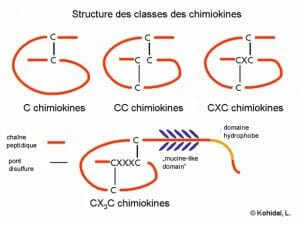Chemokines Definition
Chemokines are signaling proteins secreted by cells of the immune system that stimulate the movement of other cells. Their name is reminiscent of their function since it is derived from chemotaxis, or movement in response to a chemical stimulus, and cytokines, which are small proteins implicated in cell signaling. That is, chemokines are cytokines that stimulate movement. Chemokines play key roles in immunological reactions, in which they are secondary pro-inflammatory mediators instigated by primary pro-inflammatory mediators, and in homeostasis, in which they regulate cell movement to keep the health and the normal functions of the immune system. Not surprisingly, chemokine receptors are mostly present on the surface of white blood cells (cells predominantly involved in immunological reactions). Chemokines have been found in all vertebrates and even in some unicellular organisms such as viruses and bacteria but they have not been observed so far in any non-vertebrate.
Chemokines are very small, between 8 and 10 kDa. There are different types, all of which are very similar. Most of them share the presence of four cysteine aminoacids, two of which are used to classify all chemokines into four types. Specifically, the two aminoacids close to the N-terminus of the chemokine are used for the classification into CC, CXC, C, and CX3C types. CC chemokines have two cysteines, one next to the other; CXC have one aminoacid between the two cysteine residues; C chemokines have in total just two cysteines instead of four, one of which is at the N-terminus; and CX3C chemokines have three aminoacids between the two cysteines. The structure of these four types of chemokines can be observed here:

Chemokines Function
The function of chemokines is to generate the movement of cells. Not only this, but their function grants them two key roles: chemokines are implicated in immunological reactions and in homeostasis of the immune system.
Chemokines and Immunological Reactions
The pro-inflammatory immunological role of chemokines initiates when some cells of the immune system release chemokines and other cells detect them. The cells that release chemokines are chemoattractants, since they attract other cells to the site in which they are. These cells release chemokines when there is a pathological agent that needs to be fought against so that the organism stays healthy. This way, the presence of foreign agents, microbes or viruses elicits the release of chemokines in order for other immunological cells—white blood cells—to reach the point of invasion.
The cells that detect chemokines have receptors on the cell surface that are activated when chemokines bind to them, producing an intracellular signaling cascade that ends up generating movement. The receptors to which chemokines bind are of the G protein-coupled receptor (GPCR) type. Nineteen types have been identified until now and, similarly to chemokines, they are classified into four types depending on which chemokine binds to them: CCR, CXCR, CR and CX3CR (R for receptor). When GPCRs are activated by chemokines, they initiate the phospholipase C (PLC) signal transduction pathway. The outcome is the movement of these cells to the infection site (chemotaxis, or movement in response to chemical signals) and the release of toxic substances to get rid of the pathogens. The immunological cells attracted to the site of infection are leukocytes (white blood cells) such as monocytes, macrophages and T-lymphocytes.
Chemokines and Homeostasis
The role of chemokines in homeostasis also involves the movement of cells by chemotaxis; in this situation, however, chemokines are not released in response to any pathogen. Homeostasis refers to the regulation of all variables in the body to maintain the equilibrium needed for the body to be healthy. For example, when glucose levels are too high in the blood, the body reacts to bring them back to healthy levels or, in other words, to keep homeostasis. In the case of homeostatic chemokines, their role entails the surveillance of the immune system, encompassing processes such as the migration of leukocytes—basal leukocytes—around the immune system so that they can search for pathogens and react in response to them by inducing an immunological reaction.
Quiz
1. What is the main role of chemokines?
A. Pro-inflammatory
B. Homeostatic surveillance
C. A and B
D. None of the above
2. How do chemokines exert their function in response to the presence of pathogens?
A. They bind to receptors on the surface of pathogens and attract them to the infection site.
B. They bind to receptors on the surface of white blood cells and attract them to the infection site.
C. They are released by pathogens and attract white blood cells to the infection site.
D. They are released by white blood cells so that they can fight against the pathogen.
References
- Lodowski, D.T. & Palczewski, K. (2009). Chemokine receptors and other GPCRs. Current Opinion in HIV and AIDS, 4, 2:88–95.
